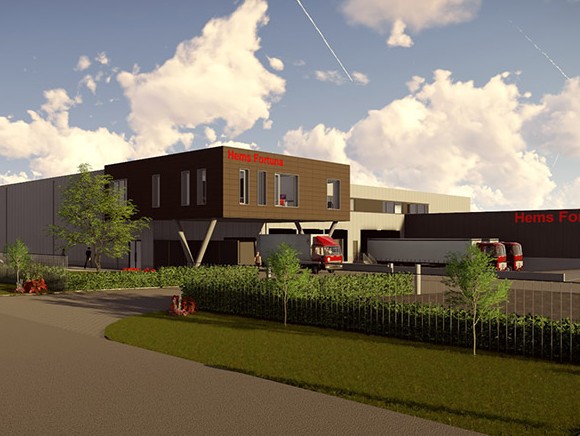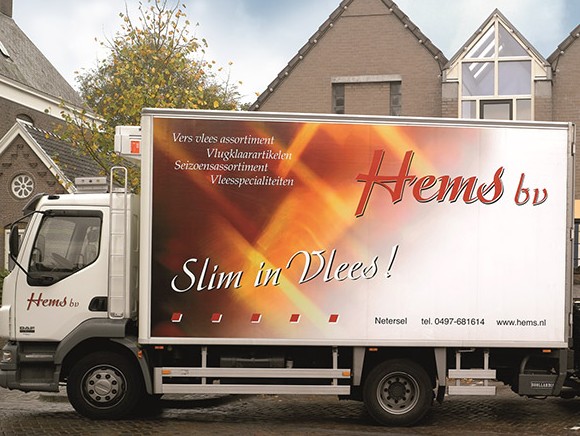
Meat company Hems is moving! In mid-November the meat processing company will be exchanging its nostalgic farm building in the Dutch village of Netersel for newly built premises in the town of Oss. Building company Aan de Stegge is supporting Hems from start to finish in terms of the engineering design, development and construction of a sustainable and food-safe facility.
Ever since the company was founded in 1985, Hems has operated from its traditional farm building – with the factory situated behind it – in Netersel in the heart of the Dutch province of Brabant. It is a real family-owned company that started out as a specialist in pork processing. For the past 12 and a half years, Robert van Grinsven has been in charge of the company’s finances. “In the early years Hems sold pork to certified butchers,” he explains. “But this only generated enough work for the mornings, so the Hems father and son team went looking for new clients and found them in the shape of Chinese restaurants.”
From that point onwards the company’s growth really took off, and Hems became a supplier for retailers and foodservice wholesalers. In addition, Hems acquired the company Fortuna based in Oss, a processor of North American beef among other things. Nowadays, Hems is almost literally bursting at the seams. Robert: “We’ve extended our premises twice since 1999. We did it as efficiently as possible, but it will never be optimal. Further expansion is impossible on our current site – we’re in the heart of the village and are surrounded on all sides. We’ve had to make the best of the space we’ve got for the past few years. The crisis meant that we had to put the new-build plans we’d made together with Aan de Stegge on hold for a while.”
In February 2016 Hems and construction company Aan de Stegge got together again to breathe new life into the building plans. The aim was to design an efficient facility where Fortuna and Hems can work together under the same roof and which offers room for further growth in the first few years. “The advantage of a new-build project is that you start with a blank canvas for your design,” comments Robert. “You can decide precisely how big you want the freezer, cold storage chambers and other areas to be. We also had clear ideas about an efficient layout for the production lines and positioning of the inbound and outbound goods areas, and we could include these in the new design.”

There are lots of aspects to take into account in a building project for a food manufacturer, according to Bas te Riele from Aan de Stegge. As the construction company knows all too well, everything revolves around hygiene and food safety. “Every food company in the Netherlands must comply with the Hazard Analysis and Critical Control Points (HACCP) as a minimum, but there’s no pragmatic interpretation of these requirements into construction solutions,” explains Bas. “We translate those demands into a building plan, anticipate any legal requirements and deliver a customised food facility that fits within the customer’s budget. For example, in the case of Hems there are extra criteria to meet because everything has to be BRC and IFS compliant.” Robert adds: “Hems is already certified to virtually the highest level of food safety, but we’re taking things yet another step further in the new facility by fitting what’s known as a sanitary ceiling.” Bas explains why this type of isolated ceiling is so practical: “There’s a gap of around three metres between the roof and the sandwich ceiling. Almost all technical systems, pipes and cables are installed above the ceiling. There’s no need to interrupt production in the case of maintenance or repairs, plus this avoids the need for technicians – with their dirty footwear or clothing – having to enter the production area.” There are more advantages associated with a new-build project: “Whereas in existing buildings you often find that a food-safe ‘box’ has been constructed inside the building, a new-build project gives you the chance to make the outer facade food-safe right from the start,” says Bas. “Here, the columns in the production area will be galvanised to avoid having any double walls with extra sealant around the edges that could harbour bacteria and mould.”
Hems is also raising the bar in terms of sustainability. Robert: “Our new building has excellent insulation and LED lighting. We recover heat from the refrigeration system to heat the water used for cleaning, which enables us to reduce our gas consumption. Our refrigeration systems are also much more modern as they are based on CO2.”

A construction meeting is held at least once a fortnight, plus Robert has frequent contact with Aan de Stegge. “I had a good feeling about this building company right from the start. Our partnership runs very smoothly.” Needless to say, he regularly drives over to the building site to take a look for himself and to chat to the contractor. No matter how much Hems continues to grow, personal contact and supplying to order will remain the top priority. “Do you know how nine out of ten butchers place their orders?” laughs Robert. “They go into their cold storage chamber and then call us to tell us what they need. And we phone our regular customers every morning. No matter how modern and sustainable our new premises will be, we’re more than happy to stay a little old-fashioned in that respect.”
Photo: Kees Hems and Bas te Riele
Source: © Hems en Aan de Stegge